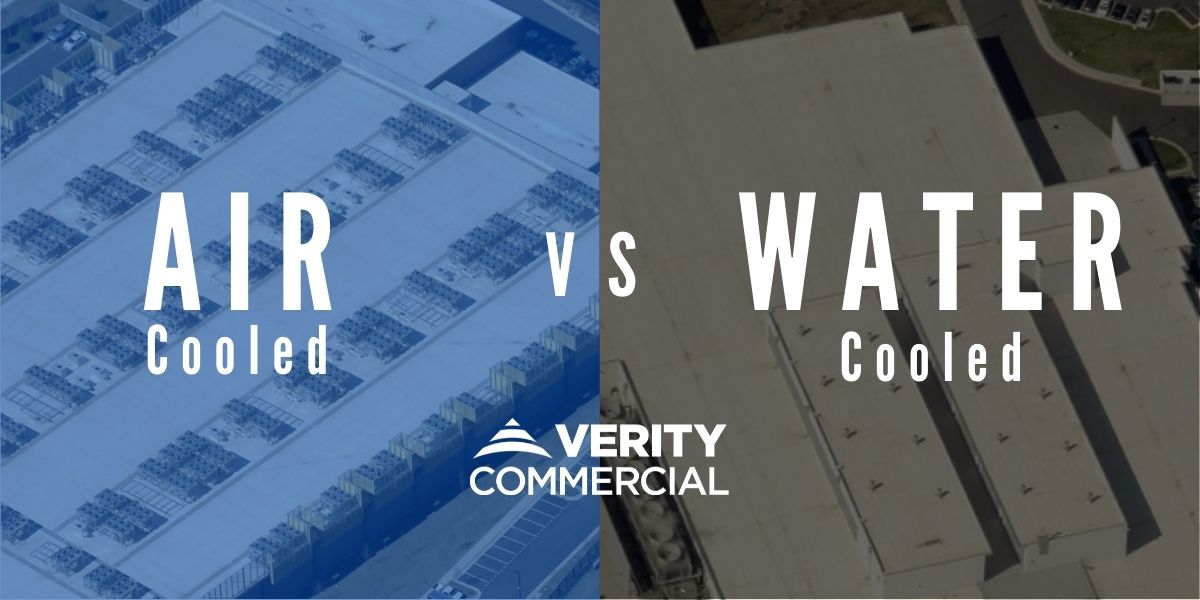Can there be differentiation in data center performance based on cooling methods?

Over the past five years or more, we at Verity Commercial have noticed a growing trend in the design of data center mechanical systems. We are tracking a movement away from the traditional, water cooled, evaporative centrifugal chiller/cooling tower plants toward other air-cooled options.
But what are the ramifications of this trend to owner/operators and the clients that lease the space? What is the industry gaining and what is being left behind as a result of these choices? What follows are some comparisons of the options and potential advantages of each.
There are some essential differences between the two design approaches. The first (as always) is cost, which breaks down into initial costs and longer-term operational expenditures; those impacting real estate and the net cost to the lessee or end user. There are also energy usage and reliability considerations. Finally, but certainly not least important, is the environmental impact.
Not surprisingly, as the data center market continues its growth trajectory, more facilities are designed with critical load capacities in the 32-to-70-megawatt range. The waste-heat removal requirements are rising with the server load capacities. While this has always been the case, as the scale increases the task becomes more challenging.
Cost Considerations: Upfront and Downstream
The differences between water-cooled and air-cooled designs are stark. In the first, there are fewer larger-capacity machines typically housed inside the facility versus multitudes of smaller-capacity air-cooled chillers or condensing units typically located on the roof, as Consulting-Specifying Engineer Magazine explains.
One major point of differentiation is the water-savings that naturally comes with air-cooled solutions. It should be noted that some owners opt for a hybrid solution that offers some reduction in water usage as Data Center Frontier explains.
The lure of air-cooled solutions appears to be first cost. The ability to utilize space that is already required and paid for–the roof–is appealing. Those real estate savings offset the increased cost per ton of the equipment. The cost of cooling towers, piping and pumping requirements are also avoided. The catch here is the hundreds–if not thousands–of motors, fans, drives, compressors, coils and other components that need to be serviced.
But, despite the higher first cost of equipment and real estate required to house water-cooled systems, fewer larger components of greater capacity housed in the controlled environment of the data center are easier to operate and can result in lower maintenance costs. Combining such factors as the better heat-transfer efficiency of water versus air (by an approximate factor of 25 times); the ease of operability; the lower maintenance costs; and the reduced energy usage, all make a solid argument for the long-term benefits and savings of an evaporative (water) solution.
Achieving a lower PUE (Power Usage Effectiveness–the ratio of critical load to total load), is a win for the lessees that are charged for the energy they use. We at Verity have discussed this previously.
Here is a quick sample calculation demonstrating how lowering the PUE directly affects the customer’s bottom line:
- Analysis: 6MW critical load;
- Reduce PUE by 0.25 (e.g., moving from 1.4 to 1.15);
- Utility rate of $0.06/kWHr;
- Annual savings of $0.79 MM;
- Every 0.1 reduction = $53/MW.
Let’s factor in the long-term lease, typically 15 years, which is the holy grail of data center leasing. As just demonstrated, reducing PUE by 0.25 saves the lessee approximately $790,000 per year. Over the term of the lease, 15 years at 6MW in this example equates to $11,850,000. Now imagine the energy cost savings to client(s) leasing a 70MW facility.
What about environmental concerns?
Noise factors need to be considered. Traditional evaporative cooling towers generate less noise than air-cooled chillers and or condensers. The difference can be as much as 10dB. Once again, we quote Consulting-Specifying Engineer Magazine: “The placement of the air-cooled chiller on the exterior of the building introduces a lot of environmental noise, and it is much louder than the cooling tower (90 to 100 dB compared to 80 to 90 dB, respectively) that is located on the building’s exterior in a water-cooled chiller plant system.” For reference, the magazine explains, a 10-dB difference is equal to twice the noise.
Then there’s the water usage. Facilities cooled evaporatively do incur fees for the service determined by type of water (potable or reclaimed) and the quantity. Of the water used, 25 percent is returned to the utility as effluent and the rest is evaporated in the cooling process and returned to the environment, as the US Geological Survey (USGS) explains.
Summing It All Up
In our experience then, taking all the above considerations into account, the trophy for least expensive system holistically seems destined for traditional evaporative chiller plants. The irony is that this does not seem to be the industry choice. As a result, data centers are increasingly being commoditized with fewer options and less differentiation between them.
As the industry gravitates toward air-cooled in lieu of water-cooled system designs, we are seeing more conversations within the industry regarding air and its true effective rate in mid-size to large data center facilities. Many operators are looking at alternative revamped water and liquid cooling systems to address air-cooling inefficiencies.
There are many factors involved in the selection and design of a data center. What will differentiate one from another? Some of these considerations have been discussed in recent blogs.
Contact Verity Commercial today for an in-depth analysis of you next data center project.
# # #
Comments